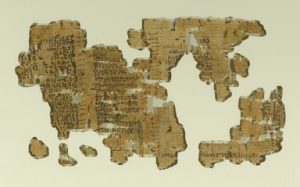In Part 1 of this series, we took note that the doctrine of naturalistic evolution functions as an overarching metasystem within academia and establishment science. The belief in evolution conditions the interpretation of virtually everything by scholars and scientists in virtually all disciplines. This foundational framework is never seriously questioned or examined. It is simply assumed to be true as a matter of faith. This applies as much to archaeology as to biology and geology.
An example of this function of evolution as an interpretative lens in archaeology can be seen in a lecture series on ancient Egypt by Professor Robert Brier of Long Island University.
After an introductory overview, Brier begins recounting Egyptian history chronologically, not with the aid of archaeology but by establishing the evolutionary framework through which he understands archaeology. He discusses the publication of Darwin’s book, On the Origin of Species by Means of Natural Selection OR The Preservation of Favored Races in the Struggle For Life, Louis Leakey’s discovery of “hominid” fossils in the Olduvai Gorge, Neanderthals, the divisions of Stone Age chronology, and so forth.
In other words, Brier lays down a naturalistic faith as the lens through which historical events are to be understood. The uniformitarian chronological time scheme of secular academia is accepted without question, with no hint of an awareness of the severe problems associated with that time scheme.
Looking at history through this lens, anything with a supernatural element to it is ruled out a priori. Brier is aware, of course, that this collides head-on with the historical Jewish and Christian understanding of the origin of the Israelites in ancient Egypt. Things such as divine providence, dreams from God, and miracles such as the parting of the sea for the Israelites to cross over to Arabia are all excluded as possibilities at the outset.
Brier, as with so many secular academicians, is not about to allow a divine foot in the door.
Beginning An Empirical Foundation of Biblical History
We will begin our examination of the actual archaeological evidence of Hebrews in ancient Egypt neither at the beginning of the Hebrews’ sojourn in Egypt nor at the end, but in between, somewhere in the timeframe of 1740 BC–1620 BC, depending upon which scholar you consult. (To give a frame of reference, following the biblical chronology, Jacob and his clan entered Egypt in 1876 BC.)
I’ve chosen the Brooklyn Papyrus (or, more formally, the “Papyrus Brooklyn 35.1446”) as the first artefactual evidence to examine because I regard the Brooklyn Papyrus as not merely “suggesting,” “indicating”, or giving “evidence for” the presence of the Hebrews in Egypt, but well-nigh incontrovertible proof of it.
Interpretation vs Direct Historical Testimony
Archaeologists labor for untold hours, even decades, evaluating and interpreting
- stratigraphic layers,
- pottery shards,
- weapons of warfare,
- bones,
- remains of structures,
- jewelry
- and numerous other artefactual evidence
in order to learn from and understand past human history.
Actual written records are of an entirely different and most precious nature. In them we have direct verbal attestation of human events, things, or conditions of the past. This is something that arrowheads, pottery, and stone walls by themselves can never give to us. Stonehenge is tantalizing — but would to God its makers had communicated what they wanted to say in writing in a language we could read. What a difference that would have made to our understanding!
This is the value of the Brooklyn Papyrus.
The Brooklyn Papyrus is, as I will show below, direct attestation of Hebrew presence in ancient Egypt, dating back possibly as long ago as 1740 BC. There is some disagreement among scholars over the exact timing of this document, as is typical of almost all ancient Egyptian chronology, but this is of no consequence because even the later estimates for the time of the papyrus still put it no later than the 1600s BC. Accepting the biblical chronology as true, the Brooklyn Papyrus comes from a time after Joseph but before the Exodus. This is true whether positing an early or late date for the Exodus.
What is the Brooklyn Papyrus?

The Brooklyn Papyrus (or the “Papyrus Brooklyn 35.1446”) is so-called because it is housed in the Brooklyn Museum in New York. The papyrus is a document written in Egyptian Hieratic script. Hieratic was the common script used by ordinary Egyptians in everyday life whether in the government or in business, and is quite distinct from the official hieroglyphic script of the Pharaohs. It was based on the hieroglyphic script but was basically a form of cursive writing. Most of these ancient writings were done on papyrus and have long since decayed into dust. Anything that remains of papyrus documentation is most fortuitous.
The Brooklyn Papyrus mentions by name the Thirteenth Dynasty Pharaoh Sobekhotep III (throne name “Sekhemre-sewadjtawy.”) who ruled Egypt for a short reign of 3-4 years. His timeframe can be reasonably narrowed down to a rule somewhere between 1740 BC – 1690 BC. This predates the popularly known Rameses II, whom many erroneously believe to be the Pharaoh of the Exodus, by some 400 years or so. Because of this mention of Sobekhotep III, my own estimate for the time of the document is that it comes from an earlier date within the proposed time ranges.
What Does the Papyrus Say?
The Brooklyn Papyrus lists 95 household servants of the Egyptian noblewoman, Senebtisi. She was the wife of Resseneb, an Egyptian vizier.
The significant thing about this document is that some of the servant names include exclusively Hebrew names. These names include:
- Shiphra (see Exo. 1:5);
- Menahema (feminine of Menahem; see 2 Ki. 15:14);
- Aqoba (the feminine form of Jacob);
- Ashera (the feminine form of Asher; see Gen. 25:26);
- Sekera (the feminine form of Issachar);
and about forty Semitic names in all, including
- Dawidi-Huwat (i.e., David);
- Esebtw derived from the Hebrew for “herb;”
- Hayah-Wr (i.e., Eve);
and (perhaps even more amazing than the naming of “Shiphra”) “HY’BRW” (Egyptian phonetic transliteration of “Hebrew”), nine distinctly Hebrew names in all. The servant, “Hy’brw,” was either an unidentified Hebrew or a Hebrew who actually had “Hebrew” as a name.
As you can see, the text of the papyrus is a phonetic one; that is, the characters represent sounds as in English.
The value of this document to biblical archaeology cannot be easily overstated. These names are distinctly Israelite, not merely Semitic. These are not the names of Canaanites, Phoenicians, Syrians—or Moabites, or Edomites, for that matter. In my opinion, this is conclusive proof of Hebrew presence in Egypt roughly 200 years after Jacob and his clan entered Egypt in 1876 BC.
Does this Hebrew servant list represent the oppression of the book of Exodus?
Or is this just incidental? It is probably too early and appears to be typical household servitude as opposed to the harsh state slavery of the Pharaohs nearing the time of the Exodus.
“See No Evil…”
I was interested to see how a renowned secular scholar of Egyptology, contemptuous of biblical faith, would view the Brooklyn Papyrus, so I consulted my copy of Donald B. Redford’s book, Egypt, Canaan, and Israel in Ancient Times. Surely, Redford would mount an imposing scholarly argument for the idea that “Shiphra” and the other Hebrew and biblical names in the document could not possibly be early Hebrews?
I searched but Redford never even mentioned the papyrus in his book! Redford covers a lot of ground and includes a lot of detail. His book is 471 pages of commentary in relatively small print. In a treatise specifically covering ancient Israel and Egypt, what is the justification for omitting consideration of this document? Given the apparent significance of the papyrus and Redford’s obvious disdain for biblicists, it is curious that he bypasses the document altogether.
Considering the existence of this document, I regard it as simply dishonest for scholars to say there is “no evidence” of the Hebrews in ancient Egypt, as is routinely done by secular scholars. The Brooklyn Papyrus is evidence, and not merely evidence but extremely strong evidence.
Timothy Mahoney’s documentary video, “Patterns of Evidence: Exodus,” includes a discussion with agnostic Egyptologist David Rohl. Rohl comments that scholars simply ignore the papyrus. I can attest to this, having searched for scholarly treatment of the Brooklyn Papyrus as it relates to the question of Hebrews in ancient Egypt and found practically nothing.
In light of this document, scholars of ancient Egypt ought to be conducting their research and analysis with the presupposition that Israelites lived in ancient Egypt at least as early as the Thirteenth Dynasty. However, this seems to be a bit too much to ask of hostile zealots of a religion like Naturalism.
Naturalists are not about to allow a divine foot in the door, and if that means ignoring empirical evidence that corroborates Scripture, then so be it. Even though there is no direct testimony of anything supernatural in the Brooklyn Papyrus, its testimony of Hebrews in ancient Egypt is simply too much to even acknowledge. It repudiates way too much ink and paper expended by secular scholars who are deeply vested, both financially and in reputation, in denying Scripture. Ignoring such information is functionally the equivalent of suppressing such information.
We will continue this series in Part 3, The Soleb Temple “Yahweh” Inscription







